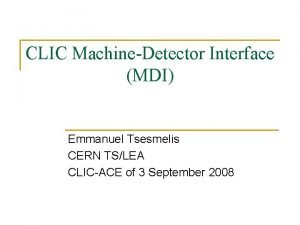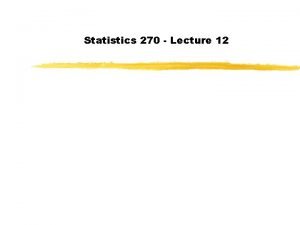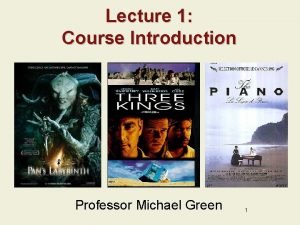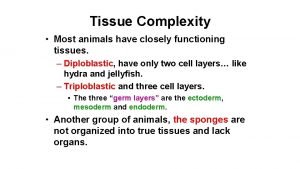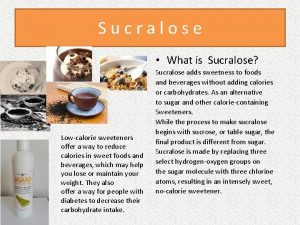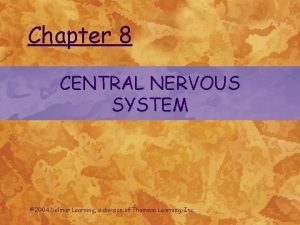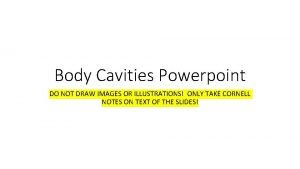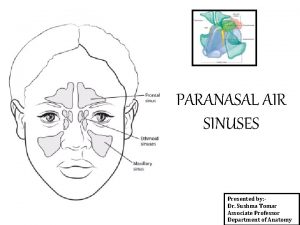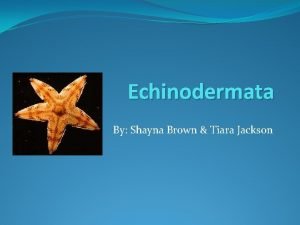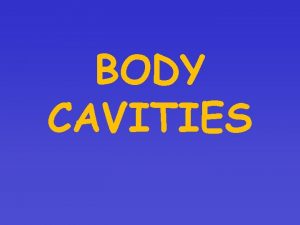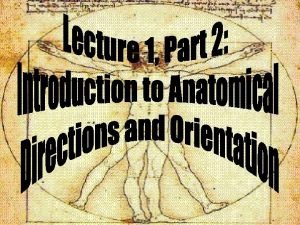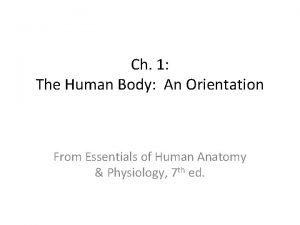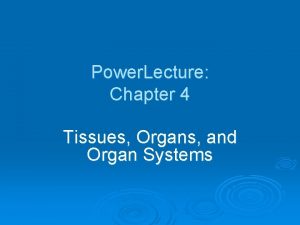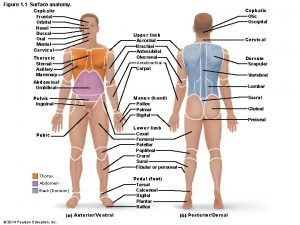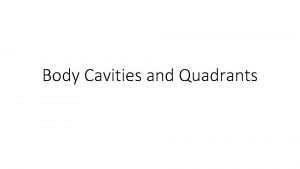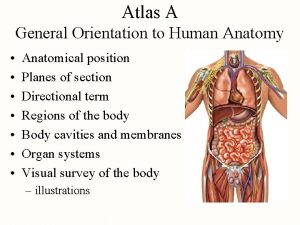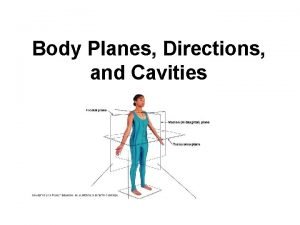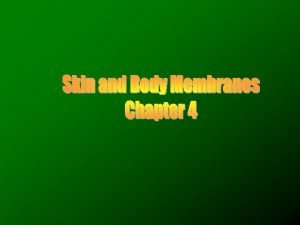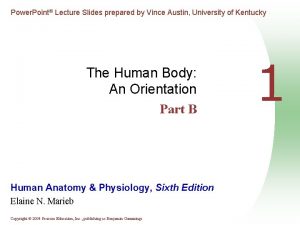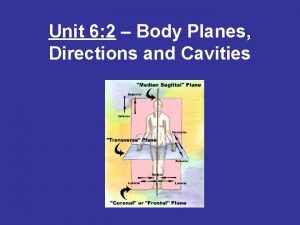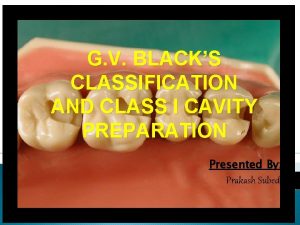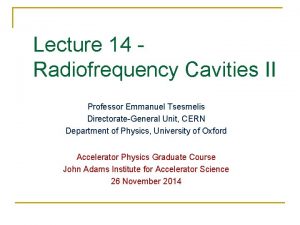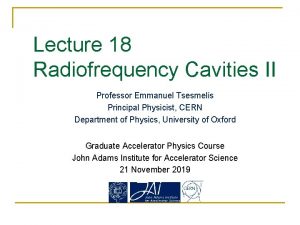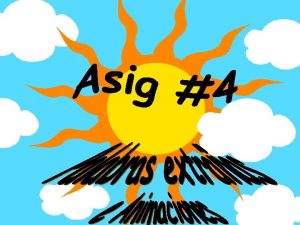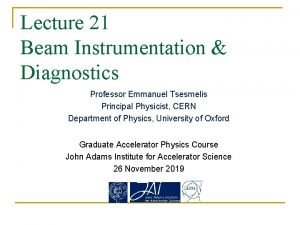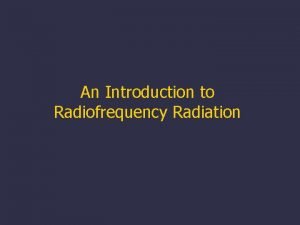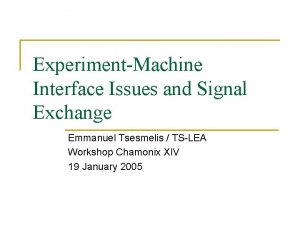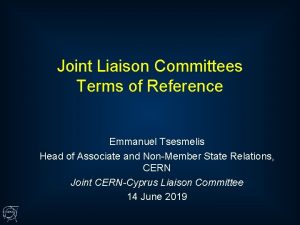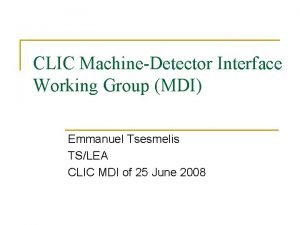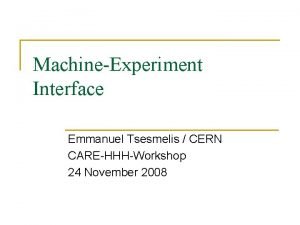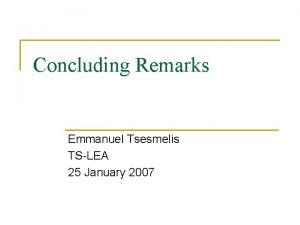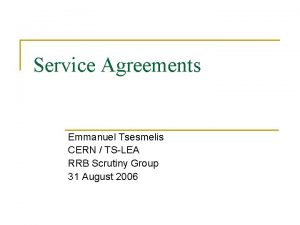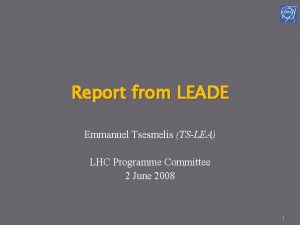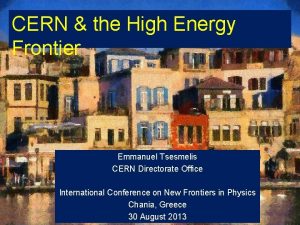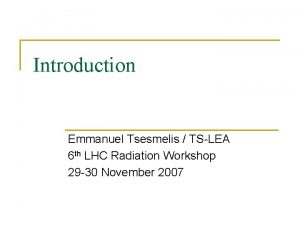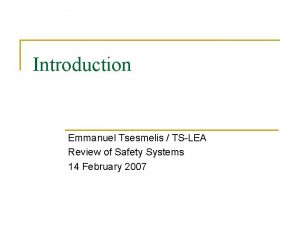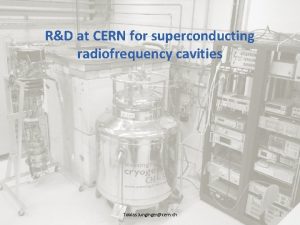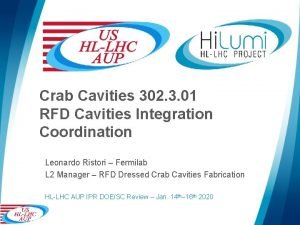Lecture 12 Radiofrequency Cavities II Professor Emmanuel Tsesmelis
































- Slides: 32

Lecture 12 Radiofrequency Cavities II Professor Emmanuel Tsesmelis Directorate-General Unit, CERN Department of Physics, University of Oxford Accelerator Physics Graduate Course John Adams Institute for Accelerator Science 18 November 2015

Table of Contents II n n n n n Group Velocity Dispersion Diagramme for Waveguide Iris-loaded Structures Resonant Cavities q Rectangular and Cylindrical Cavities Quality Factor of Resonator Shunt Impedance and Energy Gain Transit-Time Factor Kilpatrick Limit Software for Cavity Design

Group Velocity q q Energy (and information) travel with wave group velocity. Interference of two continuous waves of slightly different frequencies described by:

Group Velocity q Mean wavenumber & frequency represented by continuous wave q q q Any given phase in this wave is propagated such that kx – ωt remains constant. Phase velocity of wave is thus Envelope of pattern described by q Any point in the envelope propagates such that x dt – t dω remains constant and its velocity, i. e. group velocity, is

Dispersion Diagramme for Waveguide q Description of wave propagation down a waveguide by plotting graph of frequency, ω, against wavenumber, k = 2π/λ q q Imagine experiment in which signals of different frequencies are injected down a waveguide and the wavelength of the modes transmitted are measured. Measurables q q Phase velocity for given frequency: ω/k Group velocity: slope of tangent

Dispersion Diagramme for Waveguide q Observations q q However small the k, the frequency is always greater than the cut-off frequency. The longer the wavelength or lower the frequency, the slower is the group velocity. At cut-off frequency, no energy flows along the waveguide. Also Dispersion diagramme for waveguide is the hyperbola

Iris-loaded Structures n Acceleration in a waveguide is not possible as the phase velocity of the wave exceeds that of light. q q Particles, which are travelling slower, undergo acceleration from the passing wave for half the period but then experience an equal deceleration. Averaged over long time interval results in no net transfer of energy to the particles. • Need to modify waveguide to reduce phase velocity to match that of the particle (less than speed of light). • Install iris-shaped screens with a constant separation in the waveguide.

Iris-loaded Structures n Recall that the dispersion relation in a waveguide is n With the installation of irises, curve flattens off and crosses boundary at vφ=c at kz=π/2 With suitable choice of iris separation d the phase velocity can be set to any value

Iris-loaded Structures q Waveguides cannot be used for sustained acceleration as all points on dispersion curve lie above diagonal in dispersion diagramme. q q Dispersion diagramme for a loaded waveguide The k-value for each space harmonic is Phase velocity > c An iris-loaded structure slows down the phase velocity. By choosing any frequency in dispersion diagramme it will intercept dispersion curve at k values spaced by 2 nπ/d First rising slope used for acceleration.

Resonant Cavities n General solution of wave equation q n Describes sum of two waves – one moving in one direction and another in opposite direction If wave is totally reflected at surface then both amplitudes are the same, A=B, and q Describes field configuration which has a static amplitude 2 Acos(k·r), i. e. a standing wave.

Resonant Cavities n Resonant Wavelengths q Stable standing wave forms in fully-closed cavity if n n where l = distance between entrance and exit of waveguide after being closed off by two perpendicular sheets. only certain well-defined wavelengths λr are present in the cavity. n General resonant condition n Near the resonant wavelength, resonant cavity behaves like electrical oscillator but with much higher Q-value and corresponding lower losses of resonators made of individual coils and capacitors. q Exploited to generate high-accelerating voltages

Rectangular Resonant Cavities n Inserting into the resonance condition yields n Integers m, n, and q define modes in resonant cavity. q Number of modes is unlimited but only a few of them used in practical situations. n m, n, and q between 0 and 2

Cylindrical Resonant Cavities n Inserting the expression for cut-off frequency into general resonance condition yields q n where x 1=2. 0483 is the first zero of the Bessel function. For the case of q=0, termed the TM 010 mode, the resonant wavelength reduces to

Bessel Functions

Pill-box Cylindrical Cavity q The simplest RF cavity type Cylindrical pill-box cavity with holes for beam and coupler. q The accelerating modes of this cavity are TM 0 lm § Indices refer to the polar co-ordinates φ, r and z TM 010 TM 011 Lines of force for the electrical field.

Pill-box Cylindrical Cavity n The modes with no φ variation are: n l indicates the radial variation while m controls the number of wavelengths in the z-direction. P 0 l is the argument of the Bessel function when it crosses zero for the lth time. n q J 0(P 0 l) = 0 for P 0 l = 2. 405

Pill-box Cylindrical Cavity n TM 010 Mode

Quality Factor of Resonator, Q q Ratio of stored energy to energy dissipated per cycle divided by 2 Ws = stored energy in cavity Wd = energy dissipated per cycle divided by 2 Pd = power dissipated in cavity walls = frequency

Quality Factor of Resonator, Q q Stored energy over cavity volume is where the first integral applies to the time the energy is stored in the E-field and the second integral as it oscillates back into the H-field.

Quality Factor of Resonator, Q Losses on cavity walls are introduced by taking into account the finite conductivity of the walls. q Since, for a perfect conductor, the linear density of the current j along walls of structure is j = n H we can write q with s = inner surface of conductor

Quality Factor of Resonator, Q Rsurf = surface resistance δ = skin depth For Cu, Rsurf = 2. 61 10 -7 Ω

Shunt Impedance - Rs q Figure of merit for an accelerating cavity q q Relates accelerating voltage to the power Pd to be provided to balance the dissipation in the walls. Voltage along path followed by beam in electric field Ez is V = path |Ez(x, y, z)| dl from which (peak-to-peak)

Shunt Impedance - Rs

Energy Gain n Energy gain of particle as it travels a distance through linac structure depends only on potential difference crossed by particle:

Analogous to Electrical Oscillator q Cavity behaves as an electrical oscillator but with very high quality factor (sharp resonance) Electrical response of cavity described by parallel circuit containing C, L, and Rs On resonance the impedance is r resonant frequency Δ = frequency shift at which amplitude is reduced by -3 d. B relative to resonance peak

Transit-Time Factor The RF Gap q Accelerating gap q q q Space between drift tubes in linac structure Space between entrance and exit orifices of cavity resonator Field is varying as the particle traverses the gap q Makes cavity less efficient and resultant energy gain which is only a fraction of the peak voltage Field is uniform along gap axis and depends sinusoidally on time Phase refers to particle in middle of gap z=0 at t=0

Transit-Time Factor q q Transit-Time Factor is ratio of energy actually given to a particle passing the cavity centre at peak field to the energy that would be received if the field were constant with time at its peak value The energy gained over the gap G is:

Transit-Time Factor The Transit Gap Factor is defined as Defining a transit angle the Transit Gap Factor becomes with 0 < < 1

The Transit-Time Factor q Observations q At relativistic energies, cavity dimensions are comparable with /2 q q Reduction in efficiency due to transit-time factor is acceptable. At low energies, this is not the case q Cavities have strange re-entrant configuration to keep G short compared to dimensions of its resonant volume.

The Transit-Time Factor Field in resonant cavity q Compromise cavity design q Increasing ratio of volume/surface area q q q Reduces ohmic losses Increases Q factor Minimise gap factor ‘Nose-cones’

Kilpatrick Limit n n RF breakdown observed at very high fields. Kilpatrick Limit expresses empirical relation between accelerating frequency and E-field § f = 1. 64 Ek 2 e − 8. 5 / Ek

Software for Cavity Design Structures usually solved by Finite Element Analysis
 Emmanuel tsesmelis
Emmanuel tsesmelis Tslea
Tslea Alex cejka interview
Alex cejka interview What is mdi?
What is mdi? Promotion from associate professor to professor
Promotion from associate professor to professor A college professor never finishes his lecture
A college professor never finishes his lecture Professor green lecture 1
Professor green lecture 1 01:640:244 lecture notes - lecture 15: plat, idah, farad
01:640:244 lecture notes - lecture 15: plat, idah, farad Dorsal and ventral body cavities
Dorsal and ventral body cavities Animal body cavities
Animal body cavities What is sweeteners
What is sweeteners The brain contains four lined cavities called
The brain contains four lined cavities called Body cavities labeled
Body cavities labeled Health science 20
Health science 20 Air containing cavities in the bones around the nose
Air containing cavities in the bones around the nose Echinoderm body cavity
Echinoderm body cavity Plantago tincture for cavities
Plantago tincture for cavities Nine regions of the abdominopelvic cavity
Nine regions of the abdominopelvic cavity Palms posteriorly positioned
Palms posteriorly positioned Body orientation definition
Body orientation definition Ventral body cavity
Ventral body cavity Epigastric region
Epigastric region Fixed line of reference
Fixed line of reference Dorsal cavity diagram
Dorsal cavity diagram Body cavities and quadrants
Body cavities and quadrants Thyroid cartilage
Thyroid cartilage Supine palm
Supine palm Body cavities
Body cavities Body planes directions and cavities
Body planes directions and cavities What are the three main types of body membranes
What are the three main types of body membranes The anterior and posterior body cavities
The anterior and posterior body cavities Body planes directions and cavities
Body planes directions and cavities Line angles and point angles in class 2 cavity
Line angles and point angles in class 2 cavity

